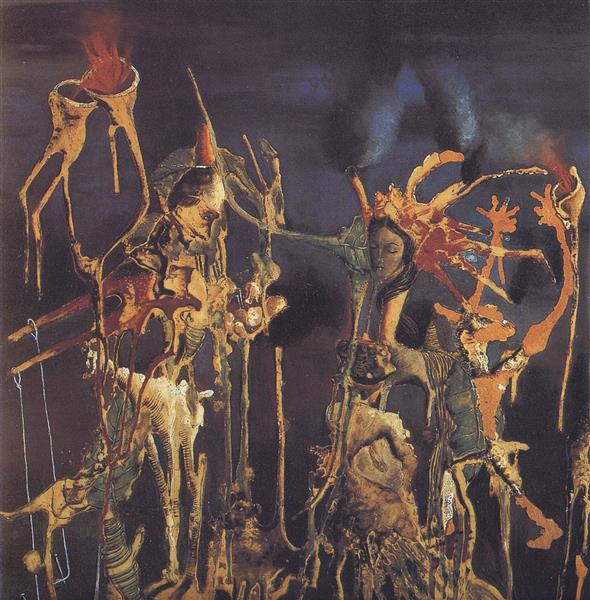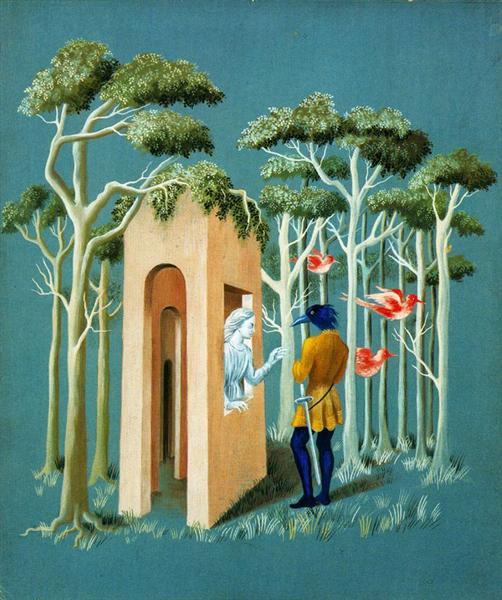The work of the intriguing artist Remedios Varo is frequently connected to surrealism. She died on October 8, 1963, in Mexico City. She was born on December 16, 1908, in Anglès, a tiny village in Catalonia, Spain. Political upheavals, especially those caused by the Spanish Civil War and World War II, shaped Varo’s life through migrations.
Varo is known for his complex and surreal imagery, which frequently includes fanciful landscapes, esoteric symbolism, and mysterious storylines. Several artistic trends influenced her, including alchemy, symbolism, and surrealism. Varo drew inspiration from esotericism, philosophy, and literature, giving her works a complex and multifaceted quality.
Varo persevered in her artistic endeavours despite several obstacles, such as financial hardships, exile, and restrictions on female artists at the time. She created a distinct visual language that still holds audiences’ attention. Varo frequently paints surreal landscapes with enigmatic people, strange animals, and cryptic machinery. Her exacting attention to symbolism and detail entices visitors to explore their imaginations’ subconscious worlds.

After moving to Mexico in the 1940s, Varo’s art gained domestic and international attention during her career. She is now regarded as one of the most significant female surrealist painters, and her paintings can be found in galleries and museums worldwide. Among many other essential pieces by Varo are “The Creation of the Birds,” “The World,” and “Exploration of the Sources of the Orinoco River.” Both artists and art fans are still inspired and intrigued by her contributions to surrealist art.
Art of Varo
Remedios Varo was a prominent member of the Surrealist movement and was well-known for her mysterious and magical paintings that examined topics related to the subconscious, alchemy, and mysticism. Varo established a unique aesthetic defined by exacting craftsmanship, deep symbolism, and surreal imagery. Her paintings frequently depict elaborate, unearthly settings home to enigmatic characters and bizarre apparatuses.
Varo added her viewpoint and influences to the genre even if she was linked to the Surrealist movement. Her paintings combine science fiction, mysticism, and personal experiences with surrealism. Varo’s work commonly explores feminine identity and women’s place in society. In defiance of conventional gender conventions, she portrayed strong, independent female figures in her paintings who frequently possessed magical abilities or participated in enigmatic rituals.

Even though Varo’s contributions were not well known when she was alive, her impact has increased dramatically since her passing. She is frequently mentioned as an inspiration by modern artists, especially those who work in surrealism, magical realism, and feminist art. Varo left behind more than just her artwork. Her personal story deepens our comprehension of her day’s political and creative battles by detailing her exile from her native Spain during the Spanish Civil War and her subsequent resettlement in Mexico.
Mysticism, Liminality
According to critics Ricki O’Rawe and Roberta Ann Quance, Remedios Varo’s surrealist work presents a heroine crossing an ‘umbral’ (limen, or threshold) beyond the natural and the supernatural. And so she underscores what other critics have identified as a dominant theme of a fantastic journey in the painter’s work. Varo’s artworks have a connection with surrealism’s trespass of other thresholds, in-between dream and waking life, the real and the marvellous, and all, at the same time, acknowledge that the point of such a crossing is to secure ‘higher knowledge’, as the painter herself stressed.
According to Ricki O’Rawe and Roberta Ann Quance, Varo has been influenced by Jung, whose theory of the psyche embraces a hermetic spiritual orientation. Still, it also knows an outward aspect focused on analysing symbols in dreams and myths. Thus, Jung offers the visual artist the possibility of translating an inner theme of a journey into an outwardly identifiable one and vice versa. By documenting the works which would have been available to Varo, we will be in a position to answer the question that is implicit in a significant body of criticism, which discusses the theme of quest in psychological or esoteric terms but has so far lacked a way to weave these strands together.

Remedios Varo / wiki
In addition, we want to suggest that the inner journey can be interpreted as the story—built up retrospectively—of a hoped-for initiation into esoteric wisdom (and all that this promises) as a preface to our analysis of the triptych Bordando del manto terrestre. On the one hand, we want to examine how the inner journey continues an early surrealist motif in her work. Such a narrative necessitates that the audience gather clues from a variety of situations and characters; it also requires us to read inferentially, both forward and backward, using symbolic imagery and an inherently metonymical process of meaning in which individual scenes repeatedly allude to effects and goals rather than achievements. We believe that Varo’s protagonists are most highly valued in the past and future.
‘Suppose there is a recurrent seeker in Varo’s painting. In that case, it is a subject in transformation typically on their way somewhere – a wanderer on a challenging road or waterway or inside a dark forest moving toward a life-giving source or spiritual boon – a pearl of great price. This chalice may be the Holy Grail. As Juliana González states, ‘lo principal son los viajes y los viajeros; todo es tránsito, paso, camino, vuelo, navegación, exploración, aventura, misteriosos desplazamientos y “llamadas”’. The question for critics is to see that this imagery is used chiefly to offer visual analogues for an inward and esoteric rebirth. Hence, Varo’s characters are often preoccupied with shedding unwanted relations, as written by Ricki O’Rawe and Roberta Ann Quance.
According to Ricki O’Rawe and Roberta Ann Quance, ‘as one would expect of an inner journey we find that there is almost always an invisible limen or threshold implied in Varo’s work: what we are given to see cannot be assigned to the world of the senses and, as we view the picture, we must suspend disbelief and accept that we have already crossed into the supernatural. Like surrealist painting in general, Varo’s painting conceptualises the frame as a window onto the marvellous which the painter ‘reveals’. The spectator sees what would not be seen if the painter were not a ‘seer’. This will surely remind one of surrealism’s celebrated focus on what the inner eye of the artist has beheld. But there is another sense, too, in which we can speak of the liminality of what we see. Typically, the spaces Varo’s characters occupy are inner or enclosed even when they open onto the heavens or to woodland.
Unexpected Journeys of Varo
‘The Outpouring of Work that Varo produced during the last ten years of her life presents a powerful, coherent study of her | preoccupations in those years. As an émigré uprooted and exiled from her homeland, she embarked on a psychological and geese pilgrimage to establish more profound, reliable roots. Having been subject to the outside forces of world events, she now sought control by creating a world of her design filled with characters — whether female, male, or androgynous — who bear her features, writes Janet A. Kaplan in her book, ‘Unexpected JourneysL The Art and Life of Remedios Varo’.
Varo did not paint self-portraits in the conventional sense; that much is certain. Despite examining herself in the mirror, she did not attempt to create a lifelike portrait. Although she often creates self-portraits, her characters are satirical, symbolic, and abstract. When placed in different scenarios, some inspired by her real-life experiences and others entirely made up, they take on symbolic meanings akin to the artist’s. Even if one is unfamiliar with Varo’s physical characteristics, the work quickly conveys its autobiographical nature due to a specific self-absorbed tone. Varo constantly explored alternate identities, both personal and universal, through these self-portrait figures, much like an actress taking on roles, in a style that swiftly became her trademark.
Varo developed an established style that she hardly ever strayed from after years of formal experimentation. She abandoned her focus on artistic innovation and instead strengthened the narrative emphasis in her paintings, looking for ways to bring her concepts to life on canvas. Her creativity was stimulated by the development of those concepts rather than the painting process itself. Varo investigated the possibilities of transformation, growth, and change with the meticulous accuracy that characterised her excruciatingly laborious style. This created a dynamic contrast between the subjects of the stories she narrated and her methodical, unchanging way of presenting them. Her style and perspective grew centred on the contrasts between process and content, freedom and control.

Remedios Varo / wiki
‘As a child dreaming of adventure, a young woman marrying to escape her family, and an artist seeking the bohemian life connected to Surrealism, the most avant-garde movement of her time, Varo was forever searching for freedom. Even after the need to travel had ended, and she could settle into the security of Mexico, Varo continued her explorations. But now, instead of physical travel, which she had come to dislike so intensely, she began a restless spiritual journey through the layers of her psyche. Transforming the idea of travel from a forced necessity into a personal symbol, she developed the image of the journey as a central metaphor in her work, as her characters emerged from the constraints of tradition, memory, fear, and isolation to seek power, creativity, spirituality, and magic, writes Janet A. Kaplan.
Fixes Audiences worldwide are still enthralled and inspired by Varo’s creative legacy. She explored fantasy, mysticism, and the subconscious in her captivating and mysterious works, crafting complex narratives that entice viewers to dig into their imaginations. Varo’s combination of technical expertise, surrealism, and symbolism is evidence of her inventive nature and lasting impact on the art world. Upon considering her accomplishments, we acknowledge Varo as a trailblazer who pushed the bounds of traditional limitations, broadened the scope of artistic expression, and was a visionary artist.
Theresa Bernstein: Daily Life Painter in a Metropolitan Settings





